
Features
Company Profiles
Roads & Paving
Capital Paving – 1st ever triple Paver of the Year
Capital Paving has won the 2008 Ontario Paver of the Year Award to become the first ever three time
May 1, 2009 By Andy Bateman
Each year, the Ontario Ministry of Transportation (MTO) recognizes the
province’s Paver of the Year and three finalists for excellent
roadbuilding on MTO contracts.
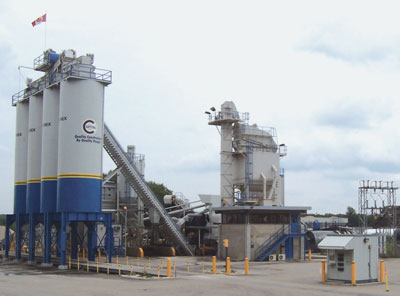
|
| Hot mix asphalt for Capital Paving’s award winning contract was produced by the company’s Terex CMI STD, 400 triple drum hot mix asphalt plant rated at 400 tonnes/h.
|
Each year, the Ontario Ministry of Transportation (MTO) recognizes the province’s Paver of the Year and three finalists for excellent roadbuilding on MTO contracts.
Capital Paving Inc. won the 2008 Paver of the Year award for an outstanding performance on MTO Contract 2006 – 3099 to follow award winning performances in 2000 and 2006. “The fact that Capital Paving is the first company to have ever won this award three times is absolutely a testament of the outstanding dedication of our employees,” Geoffrey Stephens, Capital’s President says. “I am very excited for the 2009 season; we’re committed to growing Capital and are always striving for quality. We are consistently looking for new employees with the same passion for quality of work, respect for the environment and community we work in.”
The $10.5 million job, on an 8.4 km section of Highway 7 & 8 New Hamburg from west of Waterloo Regional Road 1 to west of Waterloo Regional Road 51, consisted of the replacement of several culvert crossings, intersection widening, replacement and installation of traffic signals at four separate intersections. Additional work included rehabilitation of the Nith River Bridge, replacement of the Daimer Creek and Roth Drain culverts as well as reconstruction of Regional Road 1 and Huron Street.
Milling and paving on the contract began in June 2007. Two kilometres of the highway were pulverized and paved with two lifts of SP 19 and one lift of SP 12.5 FC-2 Superpave asphalt mixtures. The remaining 6.4 km was milled with one lift of SP 19 and one lift of SP 12.5 FC2 placed to the required cross fall.
Due to a noise bylaw restriction on this contract, work had to be done during day light hours. Highway 7 & 8 experiences high volumes of commuter traffic, making milling and paving extremely hectic and difficult at times reports project manager Rob Munro. During the working hours of 7am to 7pm there were two periods that had particularly high volumes of traffic; 8am – 10am and 3pm – 5pm. This created some tie-ups of the delivery of materials during construction and paving operations. Excellent traffic control played a major part in making this project run smoothly. “We constantly strive to provide the best possible solutions for all of our clients,” states Munro. “This is accomplished by planning the entire project before it is started. This planning has to be communicated to the other members of the team to make it effective.” All mainline paving was performed in echelon to minimize the amount of longitudinal joints. This required traffic to be moved completely to one side of the highway, reducing traffic to one lane in each direction. There had to be special consideration and deliberation to the numerous intersections throughout the contract. When traffic was switched to one side or the other, the opposing traffic had to pass through the intersection on the wrong side of the traffic island in order to give sufficient space for the paving operation. Frequently, the Ontario Provincial Police (OPP) and the Regional Police were utilized to aid with the control of the traffic through the signalized intersections. All traffic control set up was completed by Capital staff under the direction of Munro and grading foreman Robert Graham. There were many obstacles to overcome to ensure safety was always the number one priority. For instance, buffer vehicles and crash attenuator trucks were utilized as often as possible to increase the level of safety due to little separation between moving traffic and the working crews.
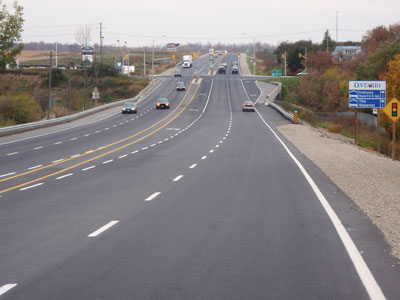 |
| Capital Paving’s award winning contract on Highway 7 & 8 received industry compliments for pavement smoothness. |
There were many challenges during the Highway 7 & 8 Project. The rehabilitation of the Nith River Bridge was completed in two stages, leaving the traffic down to two narrow lanes with a very short left turn storage lane. This area was the cause of many traffic tie ups, making it more difficult to get the supply of materials through when required.
This was the first Superpave Project that Capital attempted that incorporated recycled asphalt into the mix. This created the need to keep a very close watch on the mix changes due to the variability of the recycled material. It was first anticipated that the millings from the existing surface would be used in the SP19 but due to the quality of the RAP coming from the site this was not feasible. As a result, the site RAP was disposed of locally and the company’s existing stockpile of recycled material was used.
The early onset of winter slowed the progress of the Nith structure, moving the placement of asphalt over the structure late in the season and causing delays while waiting for sufficiently warm paving temperatures. Design changes at two of the intersections pushed the completion of the project into the spring of 2008. The surface asphalt over the Nith River was completed once the intersections were reconstructed.
“It wasn’t an easy project to complete. Communication and well maintained equipment is a must. Everyone shared the same goal and worked together to accomplish this project,” John Viveiros, asphalt foreman reports.
Capital Paving employees that worked on this project included Rob Munro, project manager; Mark Latyn, quality control manager; John Viveiros, asphalt foreman; Robert Graham, grading foreman; Andre Lavergne, asphalt plant operator; Rodney Alderdice, quality control administrator; and Terry McNeil, quality control technician.
The company’s Aberfoyle operation is home to a stationary fixed Terex CMI STD, 400 triple drum hot mix asphalt plant rated at 400 tonnes/h. The asphalt from this plant was delivered to the project site using a mix of tri-axles (22 tonnes each) and live bottom trailers (35 – 40 tonnes each). On site, paving equipment that was utilized included a Roadtec 2500C Shuttle Buggy, two Roadtec RP190 pavers with 10-20 hydraulic screeds, two Caterpillar 534D low amplitude high frequency breakdown compactors, two Caterpillar 360B rubber tire rollers and a Caterpillar 534 steel drum unit. A Barber Green 260 Paver and a Dynapac CP21 Rubber Tire Roller Capital were kept on standby equipment in case of breakdowns.
Material details for the contract include 81,000 tonnes of Granular base materials supplied by Preston Sand & Gravel Co. Ltd. The contract’s Superpave asphalt mixtures included 36,061 tonnes of SP 19 and 16,177 of SP 12.5 utilising PGAC 58-28 asphalt cement supplied by Canadian Asphalt Industries Inc., together with aggregates from Lafarge Canada Inc and Fowler Materials.
Bruno’s Contracting (Thunder Bay) Ltd
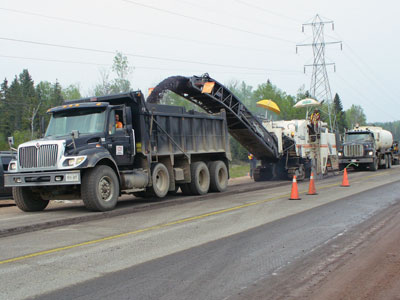 |
| Advance milling on the Bruno’s Contracting project was completed by a Wirtgen W2000 achieving an average production rate of 150 tonnes/hour. |
Bruno’s Contracting (Thunder Bay) Ltd was a finalist for top quality work on MTO Contract No. 2007-6008. This contract in the Thunder Bay district was located on Highway 11/17 and extended from 5.4 km east of the junction of Highway 587 easterly for 8.9 km. Valued at $7.4 million, work started on April 23, 2008 and was completed on September 23, 2008. Key people involved included project superintendent Nick Prystanski, project manager Kendra Dupuis, paving superintendent Danielle Boissoneau-Young, and paving foreman Gene Johnson. The scope of work included drainage, granular base, paving, milling, guard rails, culverts, together with rock & earth excavation. Bruno’s Silvio DiGregorio reports that the successful job was the result of teamwork, communication, preparation and planning, reliable equipment. Challenges faced included traffic delays as well as flooding caused by excess precipitation in May and June.
In addition to hot mix asphalt, principal job quantities included, 44,966 m3 of earth excavation (grading), 14,153 m3 of rock excavation (grading), 2,471 m2 of rock face, 11,110 m3 of rock embankment and 30.3 tonnes of granular sealing. The company’s Superior Shores pit supplied 48,268 tonnes of Granular A and 16,436 tonnes of Granular B base materials. On site, advance milling was completed by a Wirtgen W2000 achieving an average production rate of 150 tonnes/hour. Paving was done at night, with hot mix asphalt supplied by a Barber Greene DM66 Portable Thermodrum Plant with a capacity of 300 tonnes/h located in Bruno’s Hansen Pit. Mixture was hauled by International & Kenworth triaxle trucks to a site paving train including a Roadtec SB2500 shuttle buggy and Caterpillar AP-1055D equipped with Moba-Matic grade control. Compaction was completed by a Hamm 3410 smooth drum roller making three passes in the breakdown position, a Caterpillar PS300B pneumatic unit and a Hamm HD12 double drum finishing roller making three passes to achieve compacted densities of 92 per cent to 95 per cent. The reported average production rate of this train was 200 tonnes/h. Hot mix asphalt quantities included 13,559 tonnes of SP12.5 and 10,195 tonnes of SP19 mixture. Raw materials for these mixtures included McAsphalt Industries PG 64-34 asphalt cement and aggregates from Bruno’s Hansen Pit.
R.W Tomlinson Limited
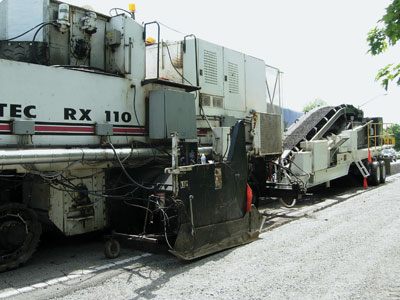
|
| Cold in-place recycled expanded asphalt mix (CiREAM) recycling on R.W Tomlinson Limited’s award winning job was completed by subcontractor Seeley & Arnill Limited. |
R.W Tomlinson Limited was a successful finalist in the MTO’s Eastern Region for excellent roadbuilding on MTO contract
number 2008-4014. This job was located on Highway 17, Renfrew and extended from 0.3 km west of Renfrew Rd No.4 (Storyland Rd) easterly for 4.1 km. Valued at $1.8 million, work started in July 2008 and completed in October, with key people including Russ Perry, Manager Highway Division; Cavie McLaurin, Asphalt Foreman; Dave Bradley, Asphalt Plant Foreman and Richard Poulin, Quality Control Asphalt.
The rehabilitation approach on this road section consisted of a single lift of asphalt over cold in-place recycled expanded asphalt mix (CiREAM) recycling completed by subcontractor Seeley & Arnill Limited. The road was also profiled and/or padded before paving started to improve final pavement smoothness numbers.
Challenges on this job included the long material haul, with asphalt trucked from Tomlinson’s Stittsville Drive asphalt plant to Renfrew, as well as waiting for test results for the CiREAM from the MTO lab.
Perry notes that good production methods achieved high quality for smoothness while excellent materials supplied by Tomlinson’s Rideau Rd Quarry allowed extremely high ERS results to be achieved. The asphalt mixture for the contract was produced by a Gencor 400 Ultradrum plant with over 700 tonnes of asphalt delivered per truck round by 20 to 25 trucks having payloads up to 43 tonnes. The site paving train included a Roadtec SB 2500B Shuttle Buggy feeding a Caterpillar AP 1000 D rubber tired paver equipped with MOBA grade controls and achieving production rates of 200 tonnes to 300 tonnes/h.
The compaction fleet following the paver included a Caterpillar CB534D breakdown compactor, Bomag BW24RH in the secondary position and a Caterpillar CB534C finishing roller, with each machine making two passes to achieve overall densities of 93.5 per cent. Raw material sources for the 6,700 tonnes of SP12.5 FC I mix placed on the contract included PGAC 64-34 asphalt cement from Bitumar Hamilton, fine aggregate from Tomlinson’s Moodie Drive Quarry and coarse aggregate from the company’s Rideau Rd Quarry.
Huron Construction Company Limited
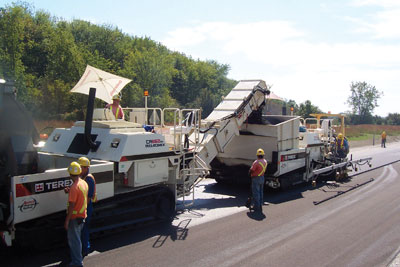
|
| Huron Construction’s paving train included two Terex CR 662RM Roadmix Machines. The leading CR662RM was on material transfer vehicle (MTV) duty while the second CR662RM was fitted with a Stretch 20 screed to pave the asphalt mat. |
Huron Construction Company Limited, building on last year’s Miller Group double, was a finalist for excellent work on contract 2007-3044 in the MTO’s Southwestern Region. The contract on Highway 40 in Lambton County, Sarnia extended from 0.2 km south of Courtright Line (Lambton Road 80) northerly for 6.0 km to 0.2 km north of Rokeby Line, for an overall length of 7.0 km. The $7.5 million job was completed in two stages, with Stage 1 completed over a three week period from September 4 to 24, 2007. Stage 2 began on May 2, 2008 and was completed five months later on October 2, 2008. Key people included project manager Joe Doyle, project supervisor Andrew Lawrence, paving supervisor Joe VanVaerenbergh, layout and inspection Paul Oldershaw and QC laboratory supervisor David (Paul) Smith.
Stage 1 of the job involved complete reconstruction of a 500 m long section of Highway 40 and its intersection with Lambton Road 80. This work had to be completed within a maximum 21 consecutive day closure of Highway 40 while maintaining public traffic through the intersection by means of a short detour. The scope of work included removal of the existing asphalt and concrete base road, earth excavation and new ditching, subdrain and culvert installation, rebuilding the road base with 450 mm of Granular “A” base, new curbs and 150 mm of Superpave asphalt paving. Additional work included new traffic lights at the intersection as well as box culvert repairs and waterproofing. For Stage 2, the scope of reconstruction work for the 7.0 km section of Highway 40 also included new traffic lights and lighting at all remaining intersections and a transition section as well as 190 mm of Superpave asphalt paving. The 2008 work was completed during very unseasonable wet weather that delayed completion of ditching, seeding and landscape operations, with water frequently pumped from ditches to keep operations on schedule.
Highway 40 was closed to through traffic, with a short term detour put into operation for Stage 1 and a long term detour in effect for Stage 2. During both stages, crossings had to be maintained at all intersections for traffic wishing to cross the closed highway and the existing concrete base and cement treated concrete base materials were recovered and processed to produce a reusable Granular A product within the Highway 40 right of way.
Doyle attributes a successful project to personnel involved in the project from supervisory staff right through to the labourers and operators running the equipment, office staff, maintenance staff and quality control personal. Everyone shared the same goal and worked together to accomplish a successful project. Best paving practices were followed by all members of the team, while well designed job mix formulas were produced by Miller Paving’s Laboratory in Aurora. Excellent communication and co-operation was maintained between Huron Construction and sub contractors Henry Heyink Construction Limited (earth excavation and drainage work), Cope Construction and Facca Construction (concrete work) and Ron Fields Electric (electrical). Success was also the result of Huron Construction’s working relationship, excellent communication and co-operation from the Contract Administration duties of Delcan Corporation and the MTO.
Turning to operations, hot mix asphalt was produced by a fixed Boeing drum mix plant with a capacity of 200 tonnes/h and hauled by broker trucks with payloads of 21 tonnes to 36 tonnes. Trucks arriving at site discharged material into the first of two Terex CR 662RM Roadmix Machines. The leading CR662RM was on material transfer vehicle (MTV) duty and fitted with a long swivel conveyor at the rear to transfer remixed asphalt from delivery trucks to the paver. The second CR662RM following behind was fitted with a Stretch 210 screed and paved the asphalt mat. Following immediately behind, the second CR662RM was in paver configuration in which a screed replaces the swivel conveyor. This particular unit was equipped with a Terex Stretch 20 screed, electric screed control heating system, rubber track pads as well as Topcon’s System Five automatic machine control system. Behind the paver, breakdown compaction was completed by a Caterpillar CB534C, making three passes. A Caterpillar PS-360B pneumatic roller then made six passes, with the mat finished by Caterpillar CB-334E and Bomag BW161AD units.
Asphalt mixes on this contract included 22,646 tonnes of SP 19 and 8,712 tonnes of SP 12.5 FC1 (Category E) mix. PG 58-28 asphalt cement was supplied by McAsphalt Industries. Suppliers of fine aggregate for the SP 12.5FC1 mix included Ontario Trap Rock for unwashed sand and Huron Construction for blending Sand. Huron Construction also supplied blending Sand for the SP 19.0mm mix while coarse sand was supplied by Lafarge Manitoulin. Coarse aggregate in the SP 12.5FC1 mix included HL-1 stone and 6.25mm chip from Ontario Trap Rock while the SP 19 mix utilised HL-8 Stone and 6.25mm chip from Lafarge Canada Inc.’s Manitoulin quarry. The Manitoulin quarry also supplied 104,500 tonnes of Granular A base material via Lafarge’s Sarnia dock, while crushing contractor Artscrushing and Recycling produced 45,700 tonnes of Granular A base on site from removed concrete base. Additional material quantities included 80,440 m3 of earth excavation, 63,246 m2 of asphalt pavement removal and 100,075 m2 of concrete base removal.
Print this page